BUS5PA Predictive Analytics Assignment 1: Model Evaluation
VerifiedAdded on 2020/03/01
|25
|2918
|37
Homework Assignment
AI Summary
This assignment, completed for the BUS5PA Predictive Analytics course at La Trobe Business School, focuses on building and evaluating predictive models for consumer loyalty analysis. The student utilizes SAS Miner to explore the ORGANICS dataset, employing decision tree and regression-based modeling techniques. The project involves setting up the project, exploratory data analysis, and data partitioning to create training and validation datasets. Decision tree models are constructed, analyzed, and compared based on metrics like average squared error and misclassification rate. Regression models are also developed, using stepwise selection and imputation of missing values. The assignment includes a detailed comparison of the decision tree and regression models, highlighting the strengths and weaknesses of each approach. Ultimately, the student concludes that a decision tree model is the most effective for this business case, offering ease of use, robustness, and interpretability. The report also includes an open-ended discussion about common pitfalls in predictive modeling, such as choosing the right target variable and avoiding overfitting, and extends the current knowledge with additional readings.
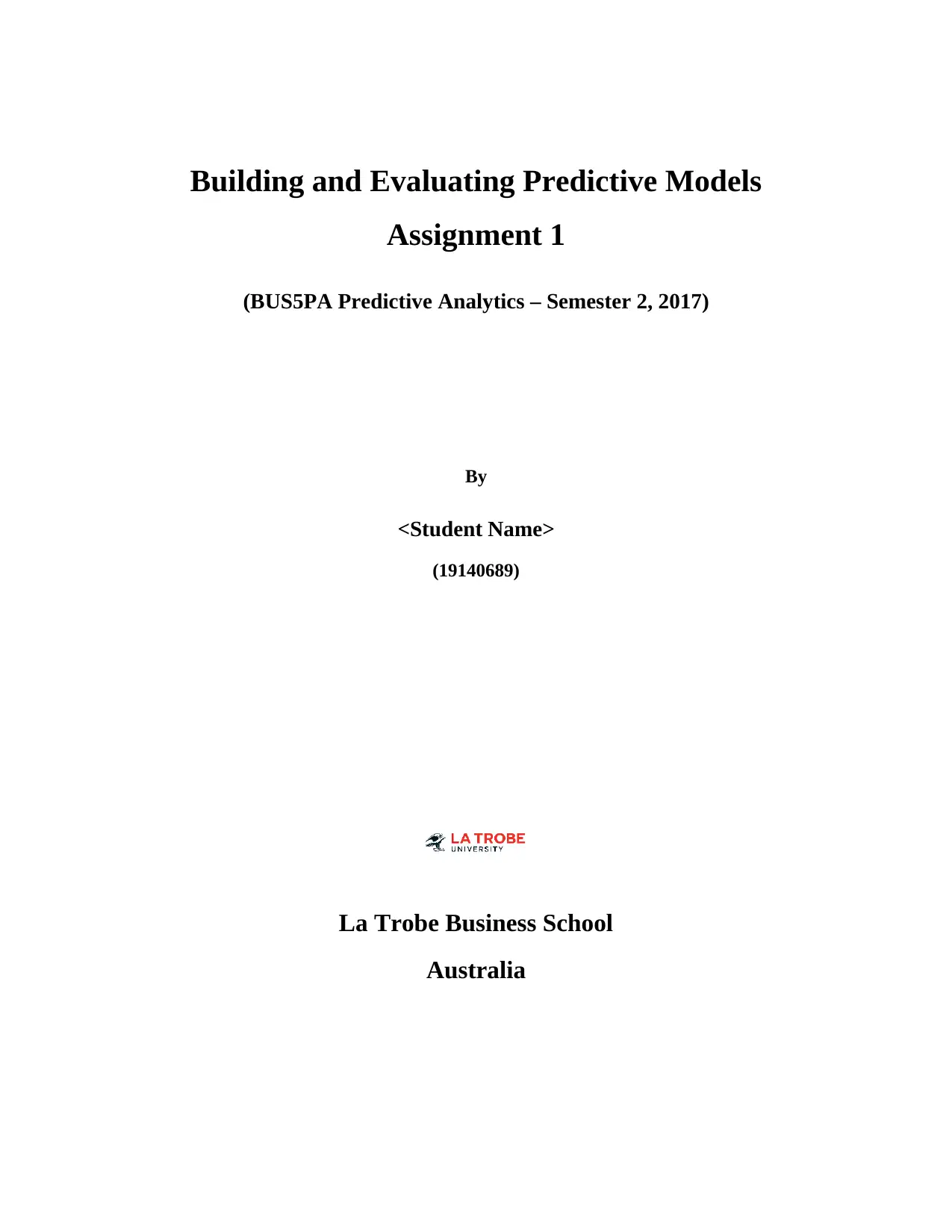
Building and Evaluating Predictive Models
Assignment 1
(BUS5PA Predictive Analytics – Semester 2, 2017)
By
<Student Name>
(19140689)
La Trobe Business School
Australia
Assignment 1
(BUS5PA Predictive Analytics – Semester 2, 2017)
By
<Student Name>
(19140689)
La Trobe Business School
Australia
Paraphrase This Document
Need a fresh take? Get an instant paraphrase of this document with our AI Paraphraser
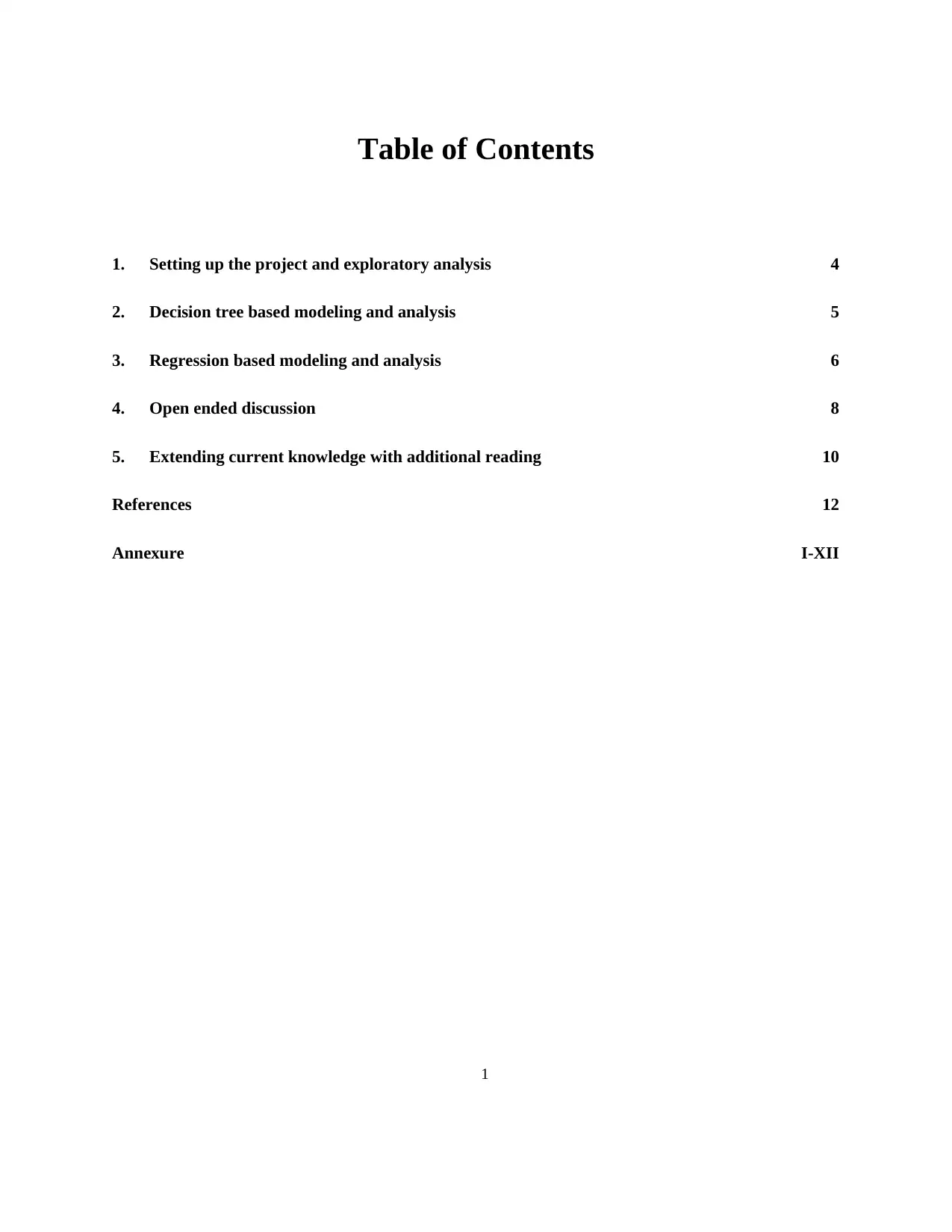
Table of Contents
1. Setting up the project and exploratory analysis 4
2. Decision tree based modeling and analysis 5
3. Regression based modeling and analysis 6
4. Open ended discussion 8
5. Extending current knowledge with additional reading 10
References 12
Annexure I-XII
1
1. Setting up the project and exploratory analysis 4
2. Decision tree based modeling and analysis 5
3. Regression based modeling and analysis 6
4. Open ended discussion 8
5. Extending current knowledge with additional reading 10
References 12
Annexure I-XII
1
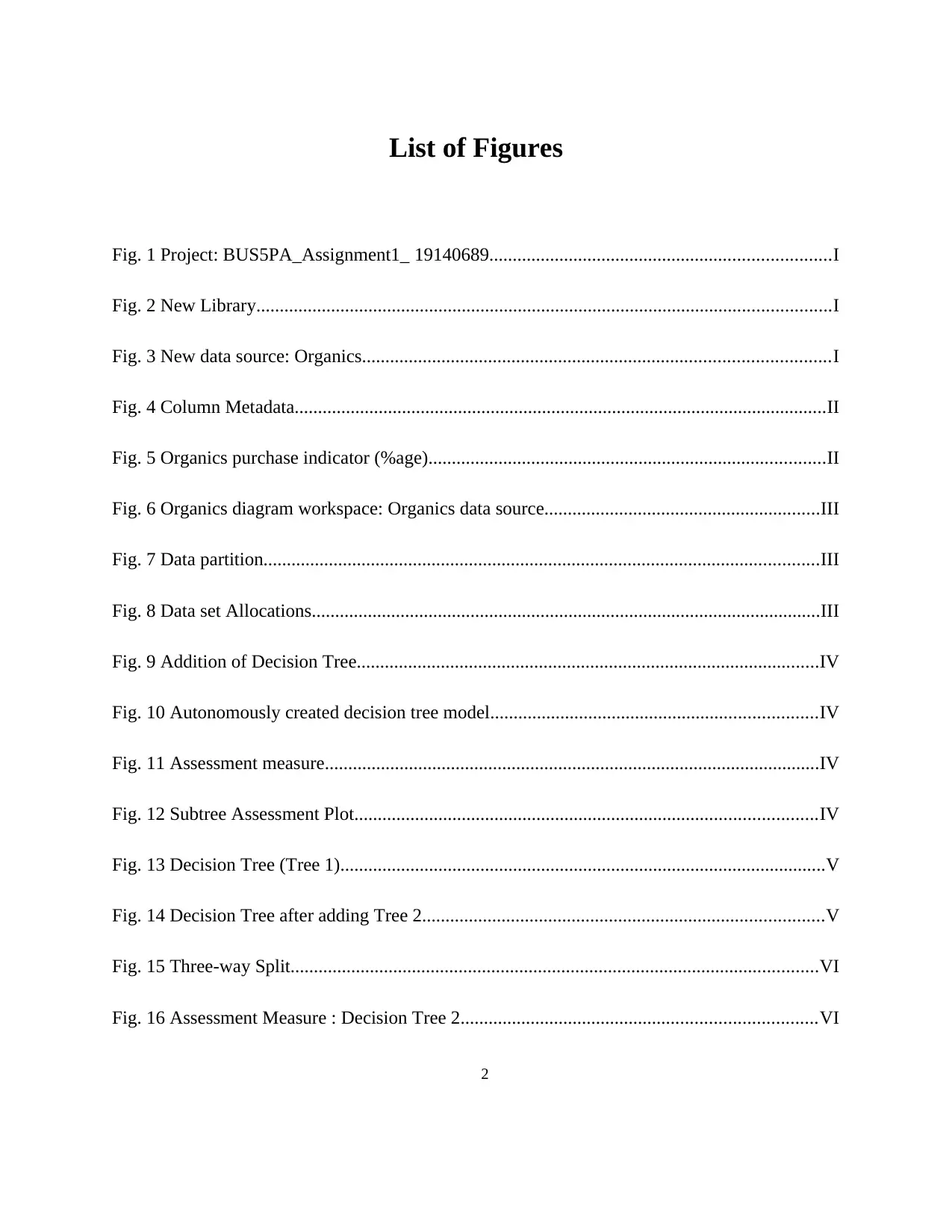
List of Figures
Fig. 1 Project: BUS5PA_Assignment1_ 19140689.........................................................................I
Fig. 2 New Library...........................................................................................................................I
Fig. 3 New data source: Organics....................................................................................................I
Fig. 4 Column Metadata..................................................................................................................II
Fig. 5 Organics purchase indicator (%age).....................................................................................II
Fig. 6 Organics diagram workspace: Organics data source...........................................................III
Fig. 7 Data partition.......................................................................................................................III
Fig. 8 Data set Allocations.............................................................................................................III
Fig. 9 Addition of Decision Tree...................................................................................................IV
Fig. 10 Autonomously created decision tree model......................................................................IV
Fig. 11 Assessment measure..........................................................................................................IV
Fig. 12 Subtree Assessment Plot...................................................................................................IV
Fig. 13 Decision Tree (Tree 1)........................................................................................................V
Fig. 14 Decision Tree after adding Tree 2......................................................................................V
Fig. 15 Three-way Split.................................................................................................................VI
Fig. 16 Assessment Measure : Decision Tree 2............................................................................VI
2
Fig. 1 Project: BUS5PA_Assignment1_ 19140689.........................................................................I
Fig. 2 New Library...........................................................................................................................I
Fig. 3 New data source: Organics....................................................................................................I
Fig. 4 Column Metadata..................................................................................................................II
Fig. 5 Organics purchase indicator (%age).....................................................................................II
Fig. 6 Organics diagram workspace: Organics data source...........................................................III
Fig. 7 Data partition.......................................................................................................................III
Fig. 8 Data set Allocations.............................................................................................................III
Fig. 9 Addition of Decision Tree...................................................................................................IV
Fig. 10 Autonomously created decision tree model......................................................................IV
Fig. 11 Assessment measure..........................................................................................................IV
Fig. 12 Subtree Assessment Plot...................................................................................................IV
Fig. 13 Decision Tree (Tree 1)........................................................................................................V
Fig. 14 Decision Tree after adding Tree 2......................................................................................V
Fig. 15 Three-way Split.................................................................................................................VI
Fig. 16 Assessment Measure : Decision Tree 2............................................................................VI
2
⊘ This is a preview!⊘
Do you want full access?
Subscribe today to unlock all pages.

Trusted by 1+ million students worldwide
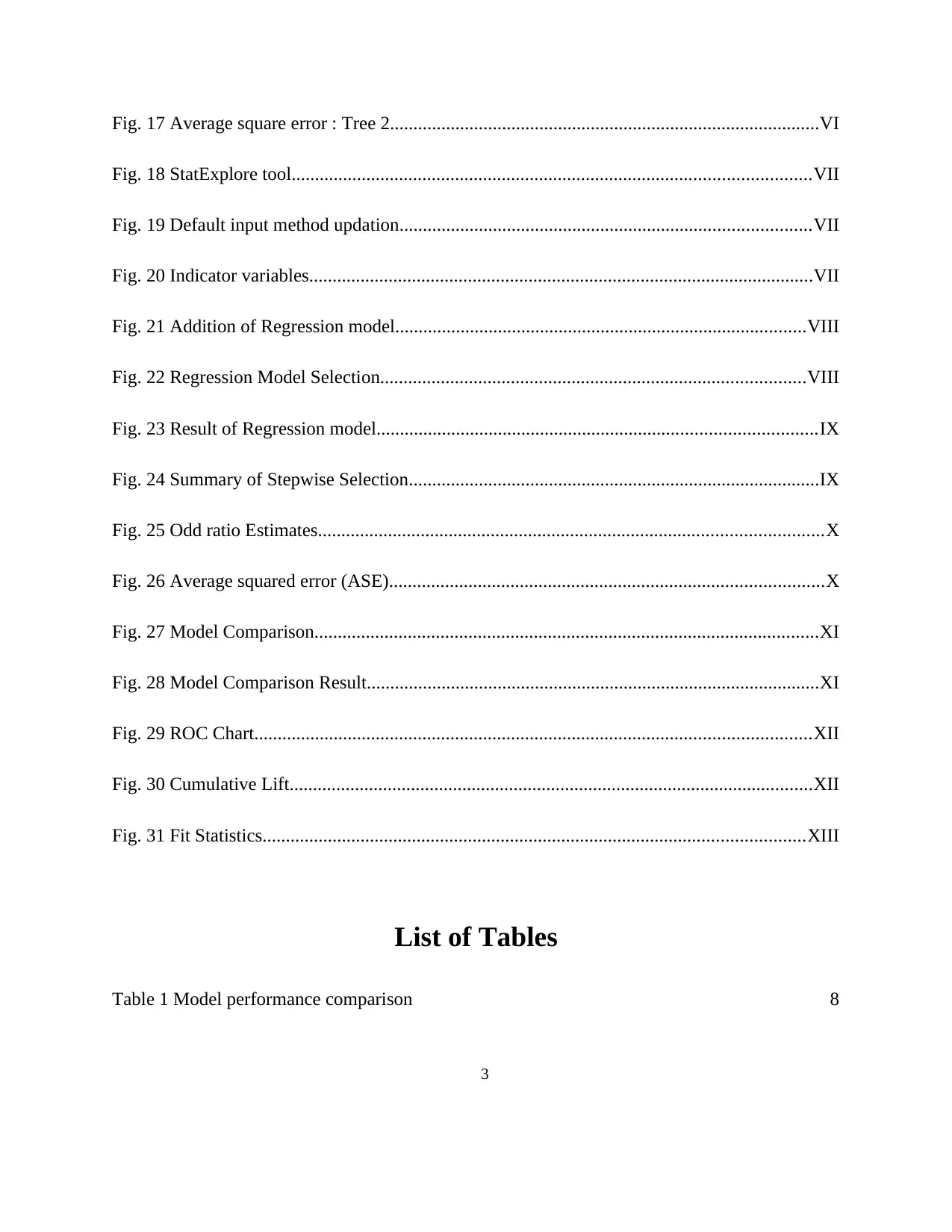
Fig. 17 Average square error : Tree 2............................................................................................VI
Fig. 18 StatExplore tool...............................................................................................................VII
Fig. 19 Default input method updation........................................................................................VII
Fig. 20 Indicator variables............................................................................................................VII
Fig. 21 Addition of Regression model........................................................................................VIII
Fig. 22 Regression Model Selection...........................................................................................VIII
Fig. 23 Result of Regression model..............................................................................................IX
Fig. 24 Summary of Stepwise Selection........................................................................................IX
Fig. 25 Odd ratio Estimates............................................................................................................X
Fig. 26 Average squared error (ASE).............................................................................................X
Fig. 27 Model Comparison............................................................................................................XI
Fig. 28 Model Comparison Result.................................................................................................XI
Fig. 29 ROC Chart.......................................................................................................................XII
Fig. 30 Cumulative Lift................................................................................................................XII
Fig. 31 Fit Statistics....................................................................................................................XIII
List of Tables
Table 1 Model performance comparison 8
3
Fig. 18 StatExplore tool...............................................................................................................VII
Fig. 19 Default input method updation........................................................................................VII
Fig. 20 Indicator variables............................................................................................................VII
Fig. 21 Addition of Regression model........................................................................................VIII
Fig. 22 Regression Model Selection...........................................................................................VIII
Fig. 23 Result of Regression model..............................................................................................IX
Fig. 24 Summary of Stepwise Selection........................................................................................IX
Fig. 25 Odd ratio Estimates............................................................................................................X
Fig. 26 Average squared error (ASE).............................................................................................X
Fig. 27 Model Comparison............................................................................................................XI
Fig. 28 Model Comparison Result.................................................................................................XI
Fig. 29 ROC Chart.......................................................................................................................XII
Fig. 30 Cumulative Lift................................................................................................................XII
Fig. 31 Fit Statistics....................................................................................................................XIII
List of Tables
Table 1 Model performance comparison 8
3
Paraphrase This Document
Need a fresh take? Get an instant paraphrase of this document with our AI Paraphraser
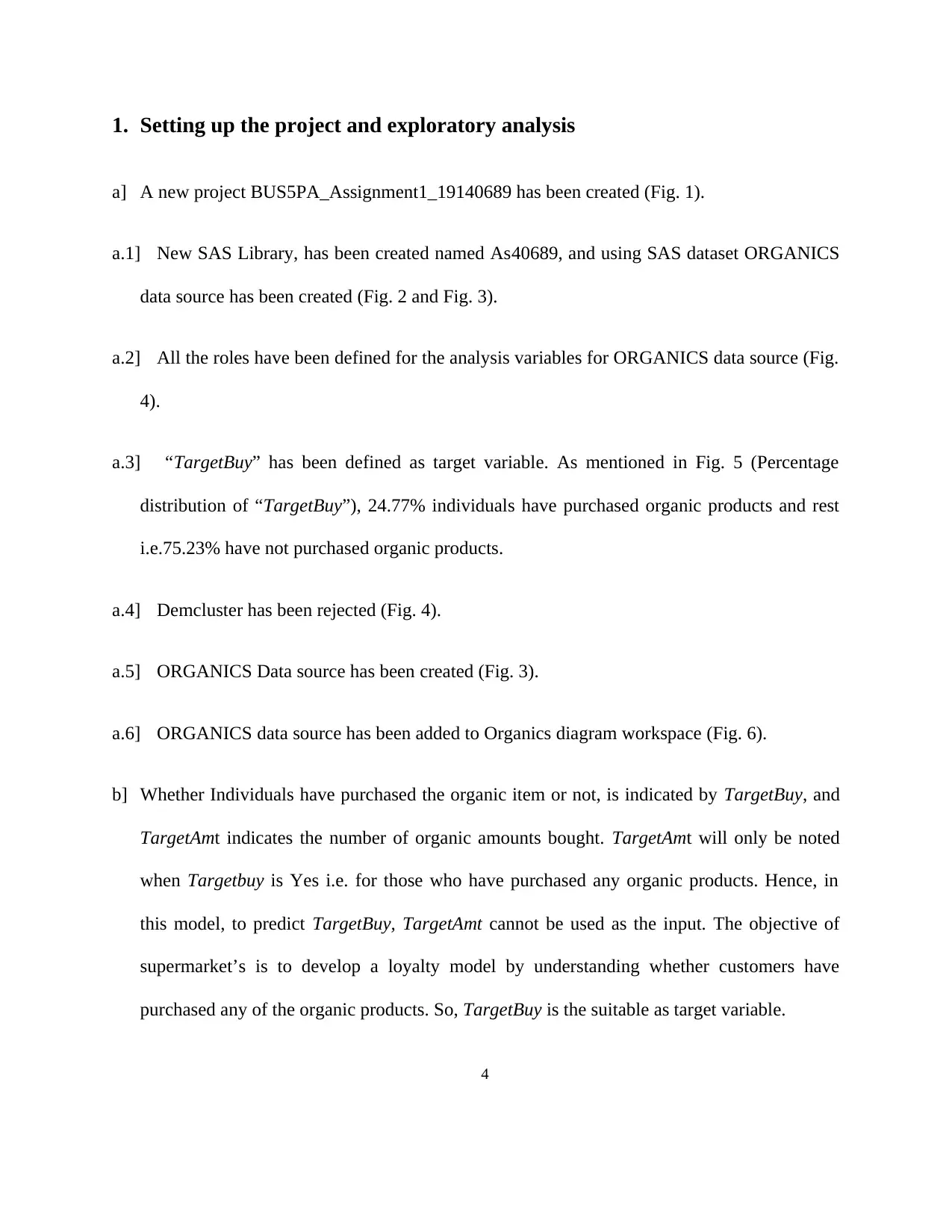
1. Setting up the project and exploratory analysis
a] A new project BUS5PA_Assignment1_19140689 has been created (Fig. 1).
a.1] New SAS Library, has been created named As40689, and using SAS dataset ORGANICS
data source has been created (Fig. 2 and Fig. 3).
a.2] All the roles have been defined for the analysis variables for ORGANICS data source (Fig.
4).
a.3] “TargetBuy” has been defined as target variable. As mentioned in Fig. 5 (Percentage
distribution of “TargetBuy”), 24.77% individuals have purchased organic products and rest
i.e.75.23% have not purchased organic products.
a.4] Demcluster has been rejected (Fig. 4).
a.5] ORGANICS Data source has been created (Fig. 3).
a.6] ORGANICS data source has been added to Organics diagram workspace (Fig. 6).
b] Whether Individuals have purchased the organic item or not, is indicated by TargetBuy, and
TargetAmt indicates the number of organic amounts bought. TargetAmt will only be noted
when Targetbuy is Yes i.e. for those who have purchased any organic products. Hence, in
this model, to predict TargetBuy, TargetAmt cannot be used as the input. The objective of
supermarket’s is to develop a loyalty model by understanding whether customers have
purchased any of the organic products. So, TargetBuy is the suitable as target variable.
4
a] A new project BUS5PA_Assignment1_19140689 has been created (Fig. 1).
a.1] New SAS Library, has been created named As40689, and using SAS dataset ORGANICS
data source has been created (Fig. 2 and Fig. 3).
a.2] All the roles have been defined for the analysis variables for ORGANICS data source (Fig.
4).
a.3] “TargetBuy” has been defined as target variable. As mentioned in Fig. 5 (Percentage
distribution of “TargetBuy”), 24.77% individuals have purchased organic products and rest
i.e.75.23% have not purchased organic products.
a.4] Demcluster has been rejected (Fig. 4).
a.5] ORGANICS Data source has been created (Fig. 3).
a.6] ORGANICS data source has been added to Organics diagram workspace (Fig. 6).
b] Whether Individuals have purchased the organic item or not, is indicated by TargetBuy, and
TargetAmt indicates the number of organic amounts bought. TargetAmt will only be noted
when Targetbuy is Yes i.e. for those who have purchased any organic products. Hence, in
this model, to predict TargetBuy, TargetAmt cannot be used as the input. The objective of
supermarket’s is to develop a loyalty model by understanding whether customers have
purchased any of the organic products. So, TargetBuy is the suitable as target variable.
4
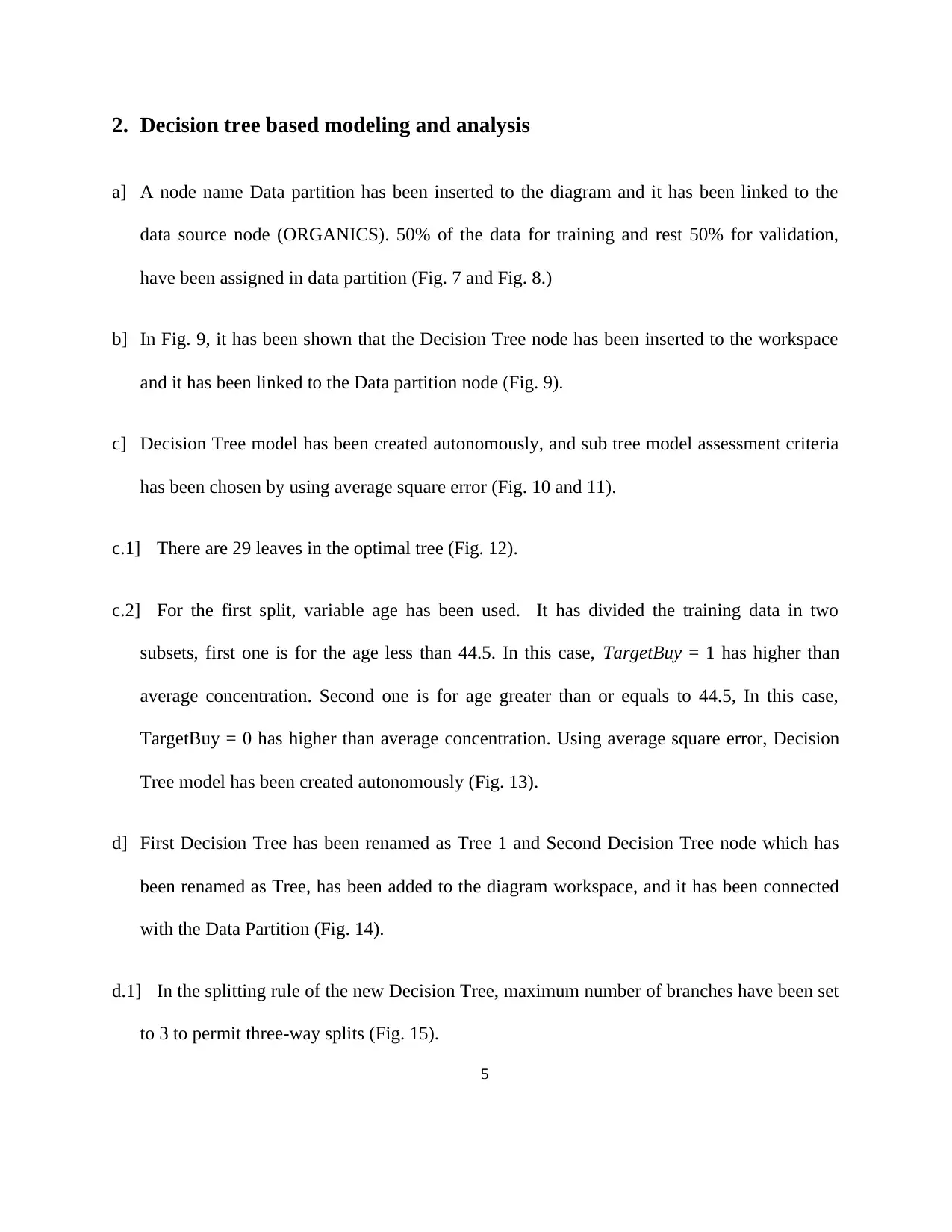
2. Decision tree based modeling and analysis
a] A node name Data partition has been inserted to the diagram and it has been linked to the
data source node (ORGANICS). 50% of the data for training and rest 50% for validation,
have been assigned in data partition (Fig. 7 and Fig. 8.)
b] In Fig. 9, it has been shown that the Decision Tree node has been inserted to the workspace
and it has been linked to the Data partition node (Fig. 9).
c] Decision Tree model has been created autonomously, and sub tree model assessment criteria
has been chosen by using average square error (Fig. 10 and 11).
c.1] There are 29 leaves in the optimal tree (Fig. 12).
c.2] For the first split, variable age has been used. It has divided the training data in two
subsets, first one is for the age less than 44.5. In this case, TargetBuy = 1 has higher than
average concentration. Second one is for age greater than or equals to 44.5, In this case,
TargetBuy = 0 has higher than average concentration. Using average square error, Decision
Tree model has been created autonomously (Fig. 13).
d] First Decision Tree has been renamed as Tree 1 and Second Decision Tree node which has
been renamed as Tree, has been added to the diagram workspace, and it has been connected
with the Data Partition (Fig. 14).
d.1] In the splitting rule of the new Decision Tree, maximum number of branches have been set
to 3 to permit three-way splits (Fig. 15).
5
a] A node name Data partition has been inserted to the diagram and it has been linked to the
data source node (ORGANICS). 50% of the data for training and rest 50% for validation,
have been assigned in data partition (Fig. 7 and Fig. 8.)
b] In Fig. 9, it has been shown that the Decision Tree node has been inserted to the workspace
and it has been linked to the Data partition node (Fig. 9).
c] Decision Tree model has been created autonomously, and sub tree model assessment criteria
has been chosen by using average square error (Fig. 10 and 11).
c.1] There are 29 leaves in the optimal tree (Fig. 12).
c.2] For the first split, variable age has been used. It has divided the training data in two
subsets, first one is for the age less than 44.5. In this case, TargetBuy = 1 has higher than
average concentration. Second one is for age greater than or equals to 44.5, In this case,
TargetBuy = 0 has higher than average concentration. Using average square error, Decision
Tree model has been created autonomously (Fig. 13).
d] First Decision Tree has been renamed as Tree 1 and Second Decision Tree node which has
been renamed as Tree, has been added to the diagram workspace, and it has been connected
with the Data Partition (Fig. 14).
d.1] In the splitting rule of the new Decision Tree, maximum number of branches have been set
to 3 to permit three-way splits (Fig. 15).
5
⊘ This is a preview!⊘
Do you want full access?
Subscribe today to unlock all pages.

Trusted by 1+ million students worldwide
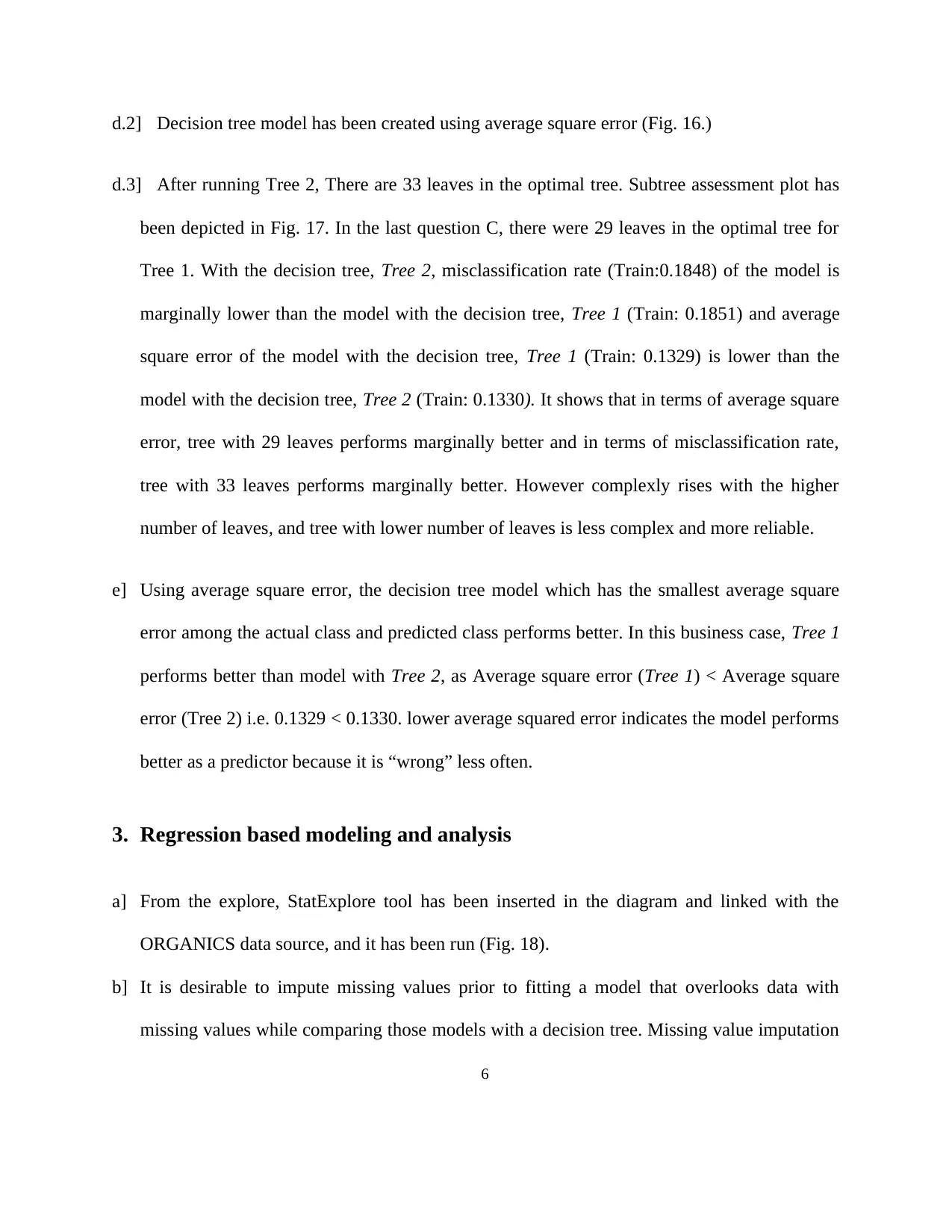
d.2] Decision tree model has been created using average square error (Fig. 16.)
d.3] After running Tree 2, There are 33 leaves in the optimal tree. Subtree assessment plot has
been depicted in Fig. 17. In the last question C, there were 29 leaves in the optimal tree for
Tree 1. With the decision tree, Tree 2, misclassification rate (Train:0.1848) of the model is
marginally lower than the model with the decision tree, Tree 1 (Train: 0.1851) and average
square error of the model with the decision tree, Tree 1 (Train: 0.1329) is lower than the
model with the decision tree, Tree 2 (Train: 0.1330). It shows that in terms of average square
error, tree with 29 leaves performs marginally better and in terms of misclassification rate,
tree with 33 leaves performs marginally better. However complexly rises with the higher
number of leaves, and tree with lower number of leaves is less complex and more reliable.
e] Using average square error, the decision tree model which has the smallest average square
error among the actual class and predicted class performs better. In this business case, Tree 1
performs better than model with Tree 2, as Average square error (Tree 1) < Average square
error (Tree 2) i.e. 0.1329 < 0.1330. lower average squared error indicates the model performs
better as a predictor because it is “wrong” less often.
3. Regression based modeling and analysis
a] From the explore, StatExplore tool has been inserted in the diagram and linked with the
ORGANICS data source, and it has been run (Fig. 18).
b] It is desirable to impute missing values prior to fitting a model that overlooks data with
missing values while comparing those models with a decision tree. Missing value imputation
6
d.3] After running Tree 2, There are 33 leaves in the optimal tree. Subtree assessment plot has
been depicted in Fig. 17. In the last question C, there were 29 leaves in the optimal tree for
Tree 1. With the decision tree, Tree 2, misclassification rate (Train:0.1848) of the model is
marginally lower than the model with the decision tree, Tree 1 (Train: 0.1851) and average
square error of the model with the decision tree, Tree 1 (Train: 0.1329) is lower than the
model with the decision tree, Tree 2 (Train: 0.1330). It shows that in terms of average square
error, tree with 29 leaves performs marginally better and in terms of misclassification rate,
tree with 33 leaves performs marginally better. However complexly rises with the higher
number of leaves, and tree with lower number of leaves is less complex and more reliable.
e] Using average square error, the decision tree model which has the smallest average square
error among the actual class and predicted class performs better. In this business case, Tree 1
performs better than model with Tree 2, as Average square error (Tree 1) < Average square
error (Tree 2) i.e. 0.1329 < 0.1330. lower average squared error indicates the model performs
better as a predictor because it is “wrong” less often.
3. Regression based modeling and analysis
a] From the explore, StatExplore tool has been inserted in the diagram and linked with the
ORGANICS data source, and it has been run (Fig. 18).
b] It is desirable to impute missing values prior to fitting a model that overlooks data with
missing values while comparing those models with a decision tree. Missing value imputation
6
Paraphrase This Document
Need a fresh take? Get an instant paraphrase of this document with our AI Paraphraser
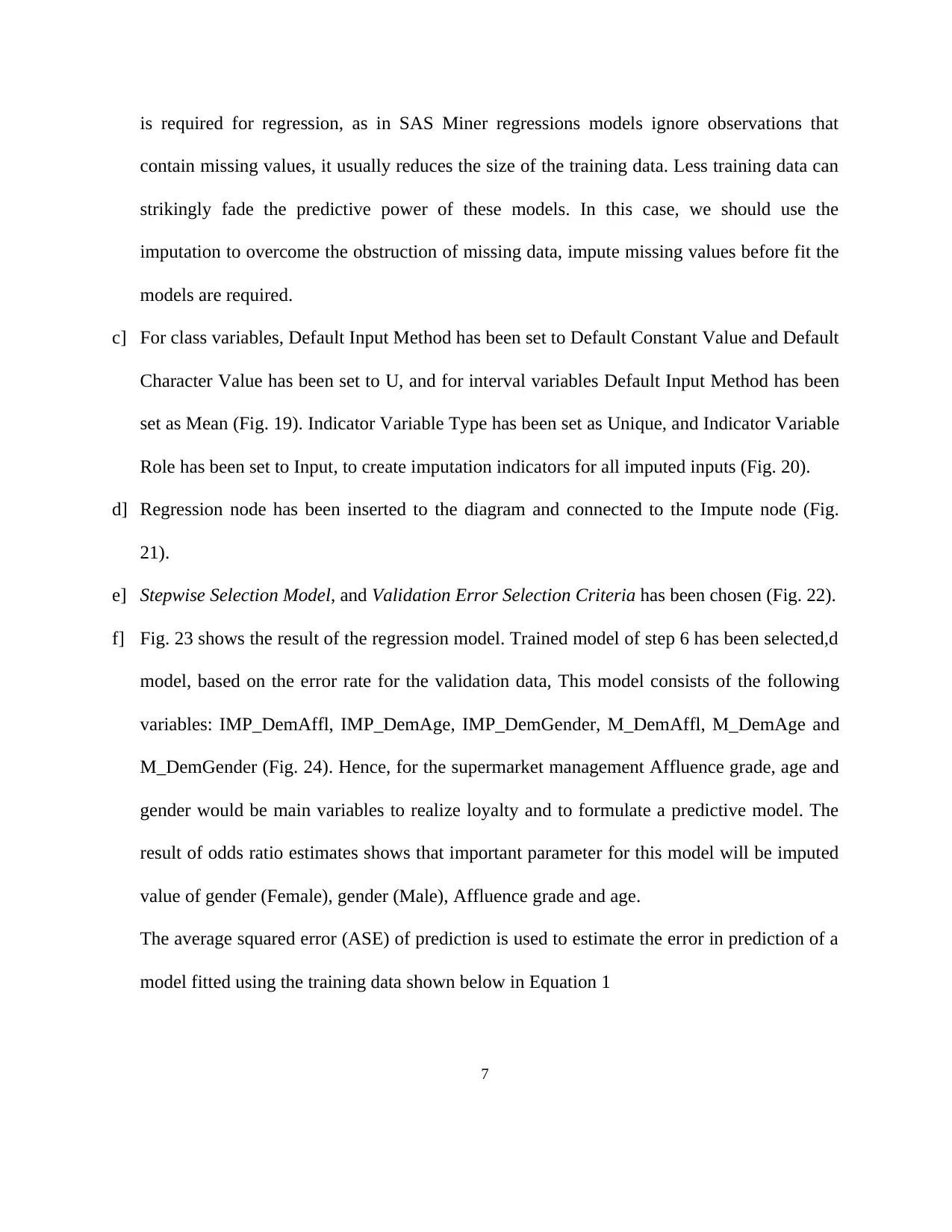
is required for regression, as in SAS Miner regressions models ignore observations that
contain missing values, it usually reduces the size of the training data. Less training data can
strikingly fade the predictive power of these models. In this case, we should use the
imputation to overcome the obstruction of missing data, impute missing values before fit the
models are required.
c] For class variables, Default Input Method has been set to Default Constant Value and Default
Character Value has been set to U, and for interval variables Default Input Method has been
set as Mean (Fig. 19). Indicator Variable Type has been set as Unique, and Indicator Variable
Role has been set to Input, to create imputation indicators for all imputed inputs (Fig. 20).
d] Regression node has been inserted to the diagram and connected to the Impute node (Fig.
21).
e] Stepwise Selection Model, and Validation Error Selection Criteria has been chosen (Fig. 22).
f] Fig. 23 shows the result of the regression model. Trained model of step 6 has been selected,d
model, based on the error rate for the validation data, This model consists of the following
variables: IMP_DemAffl, IMP_DemAge, IMP_DemGender, M_DemAffl, M_DemAge and
M_DemGender (Fig. 24). Hence, for the supermarket management Affluence grade, age and
gender would be main variables to realize loyalty and to formulate a predictive model. The
result of odds ratio estimates shows that important parameter for this model will be imputed
value of gender (Female), gender (Male), Affluence grade and age.
The average squared error (ASE) of prediction is used to estimate the error in prediction of a
model fitted using the training data shown below in Equation 1
7
contain missing values, it usually reduces the size of the training data. Less training data can
strikingly fade the predictive power of these models. In this case, we should use the
imputation to overcome the obstruction of missing data, impute missing values before fit the
models are required.
c] For class variables, Default Input Method has been set to Default Constant Value and Default
Character Value has been set to U, and for interval variables Default Input Method has been
set as Mean (Fig. 19). Indicator Variable Type has been set as Unique, and Indicator Variable
Role has been set to Input, to create imputation indicators for all imputed inputs (Fig. 20).
d] Regression node has been inserted to the diagram and connected to the Impute node (Fig.
21).
e] Stepwise Selection Model, and Validation Error Selection Criteria has been chosen (Fig. 22).
f] Fig. 23 shows the result of the regression model. Trained model of step 6 has been selected,d
model, based on the error rate for the validation data, This model consists of the following
variables: IMP_DemAffl, IMP_DemAge, IMP_DemGender, M_DemAffl, M_DemAge and
M_DemGender (Fig. 24). Hence, for the supermarket management Affluence grade, age and
gender would be main variables to realize loyalty and to formulate a predictive model. The
result of odds ratio estimates shows that important parameter for this model will be imputed
value of gender (Female), gender (Male), Affluence grade and age.
The average squared error (ASE) of prediction is used to estimate the error in prediction of a
model fitted using the training data shown below in Equation 1
7
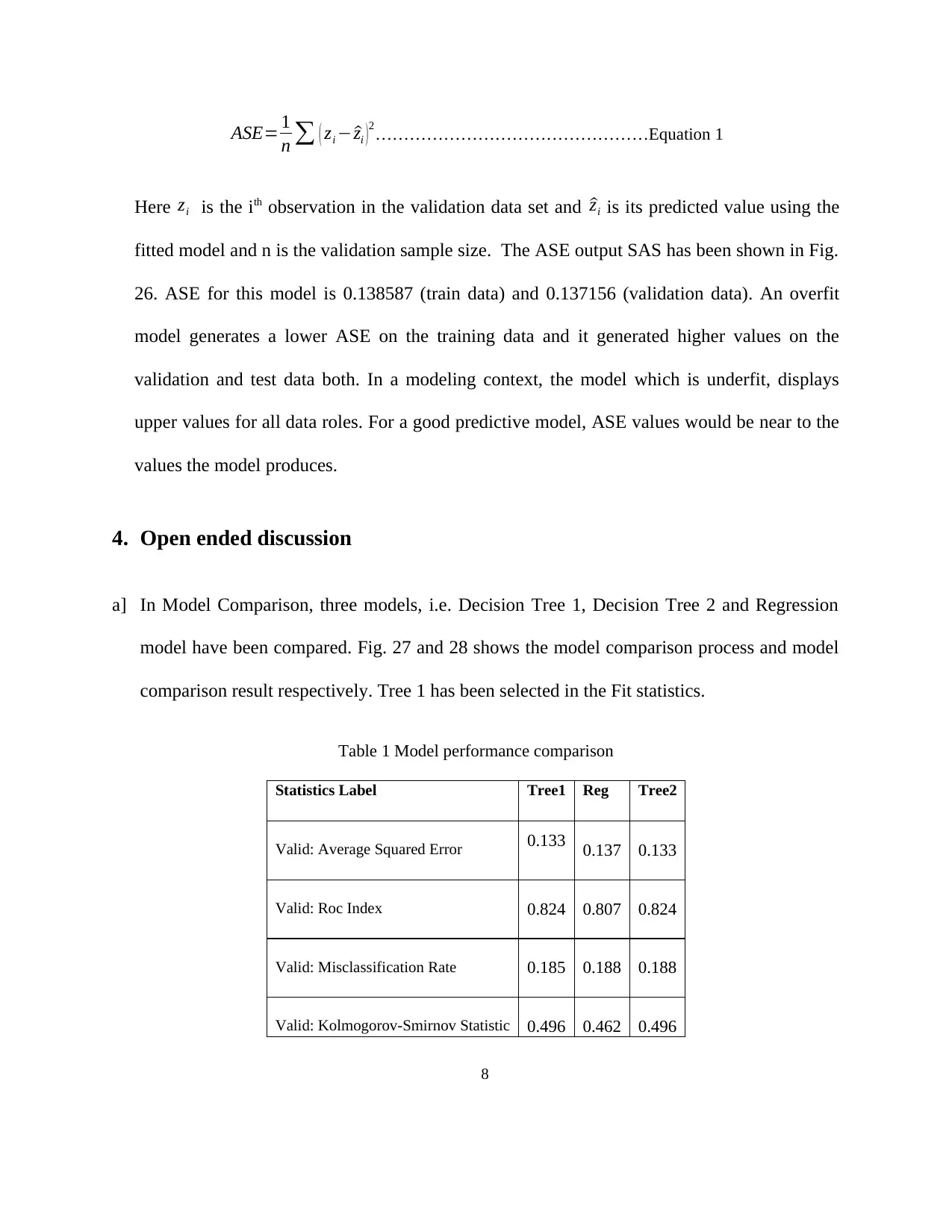
ASE= 1
n ∑ ( zi − ^zi )
2…………………………………………Equation 1
Here zi is the ith observation in the validation data set and ^zi is its predicted value using the
fitted model and n is the validation sample size. The ASE output SAS has been shown in Fig.
26. ASE for this model is 0.138587 (train data) and 0.137156 (validation data). An overfit
model generates a lower ASE on the training data and it generated higher values on the
validation and test data both. In a modeling context, the model which is underfit, displays
upper values for all data roles. For a good predictive model, ASE values would be near to the
values the model produces.
4. Open ended discussion
a] In Model Comparison, three models, i.e. Decision Tree 1, Decision Tree 2 and Regression
model have been compared. Fig. 27 and 28 shows the model comparison process and model
comparison result respectively. Tree 1 has been selected in the Fit statistics.
Table 1 Model performance comparison
Statistics Label Tree1 Reg Tree2
Valid: Average Squared Error 0.133 0.137 0.133
Valid: Roc Index 0.824 0.807 0.824
Valid: Misclassification Rate 0.185 0.188 0.188
Valid: Kolmogorov-Smirnov Statistic 0.496 0.462 0.496
8
n ∑ ( zi − ^zi )
2…………………………………………Equation 1
Here zi is the ith observation in the validation data set and ^zi is its predicted value using the
fitted model and n is the validation sample size. The ASE output SAS has been shown in Fig.
26. ASE for this model is 0.138587 (train data) and 0.137156 (validation data). An overfit
model generates a lower ASE on the training data and it generated higher values on the
validation and test data both. In a modeling context, the model which is underfit, displays
upper values for all data roles. For a good predictive model, ASE values would be near to the
values the model produces.
4. Open ended discussion
a] In Model Comparison, three models, i.e. Decision Tree 1, Decision Tree 2 and Regression
model have been compared. Fig. 27 and 28 shows the model comparison process and model
comparison result respectively. Tree 1 has been selected in the Fit statistics.
Table 1 Model performance comparison
Statistics Label Tree1 Reg Tree2
Valid: Average Squared Error 0.133 0.137 0.133
Valid: Roc Index 0.824 0.807 0.824
Valid: Misclassification Rate 0.185 0.188 0.188
Valid: Kolmogorov-Smirnov Statistic 0.496 0.462 0.496
8
⊘ This is a preview!⊘
Do you want full access?
Subscribe today to unlock all pages.

Trusted by 1+ million students worldwide
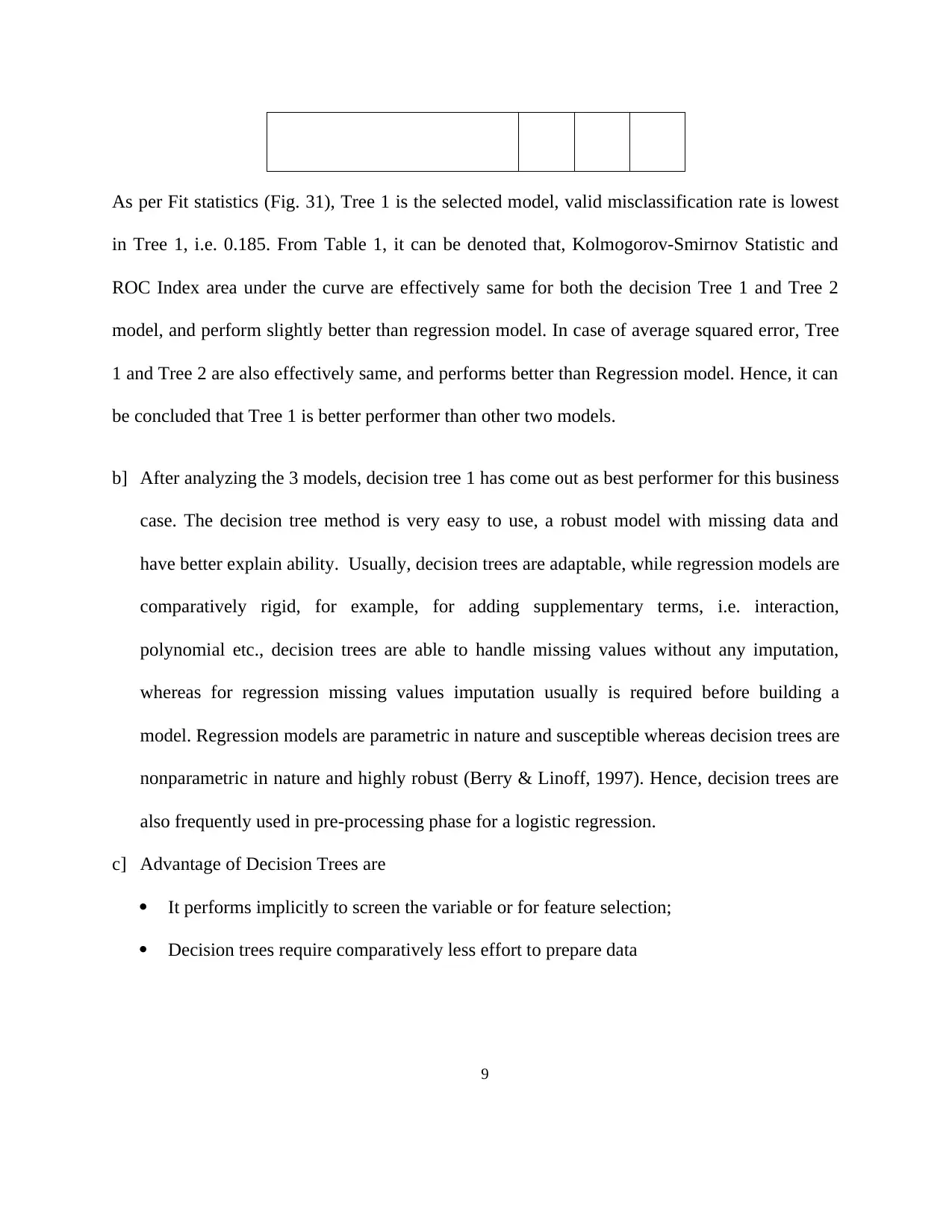
As per Fit statistics (Fig. 31), Tree 1 is the selected model, valid misclassification rate is lowest
in Tree 1, i.e. 0.185. From Table 1, it can be denoted that, Kolmogorov-Smirnov Statistic and
ROC Index area under the curve are effectively same for both the decision Tree 1 and Tree 2
model, and perform slightly better than regression model. In case of average squared error, Tree
1 and Tree 2 are also effectively same, and performs better than Regression model. Hence, it can
be concluded that Tree 1 is better performer than other two models.
b] After analyzing the 3 models, decision tree 1 has come out as best performer for this business
case. The decision tree method is very easy to use, a robust model with missing data and
have better explain ability. Usually, decision trees are adaptable, while regression models are
comparatively rigid, for example, for adding supplementary terms, i.e. interaction,
polynomial etc., decision trees are able to handle missing values without any imputation,
whereas for regression missing values imputation usually is required before building a
model. Regression models are parametric in nature and susceptible whereas decision trees are
nonparametric in nature and highly robust (Berry & Linoff, 1997). Hence, decision trees are
also frequently used in pre-processing phase for a logistic regression.
c] Advantage of Decision Trees are
It performs implicitly to screen the variable or for feature selection;
Decision trees require comparatively less effort to prepare data
9
in Tree 1, i.e. 0.185. From Table 1, it can be denoted that, Kolmogorov-Smirnov Statistic and
ROC Index area under the curve are effectively same for both the decision Tree 1 and Tree 2
model, and perform slightly better than regression model. In case of average squared error, Tree
1 and Tree 2 are also effectively same, and performs better than Regression model. Hence, it can
be concluded that Tree 1 is better performer than other two models.
b] After analyzing the 3 models, decision tree 1 has come out as best performer for this business
case. The decision tree method is very easy to use, a robust model with missing data and
have better explain ability. Usually, decision trees are adaptable, while regression models are
comparatively rigid, for example, for adding supplementary terms, i.e. interaction,
polynomial etc., decision trees are able to handle missing values without any imputation,
whereas for regression missing values imputation usually is required before building a
model. Regression models are parametric in nature and susceptible whereas decision trees are
nonparametric in nature and highly robust (Berry & Linoff, 1997). Hence, decision trees are
also frequently used in pre-processing phase for a logistic regression.
c] Advantage of Decision Trees are
It performs implicitly to screen the variable or for feature selection;
Decision trees require comparatively less effort to prepare data
9
Paraphrase This Document
Need a fresh take? Get an instant paraphrase of this document with our AI Paraphraser
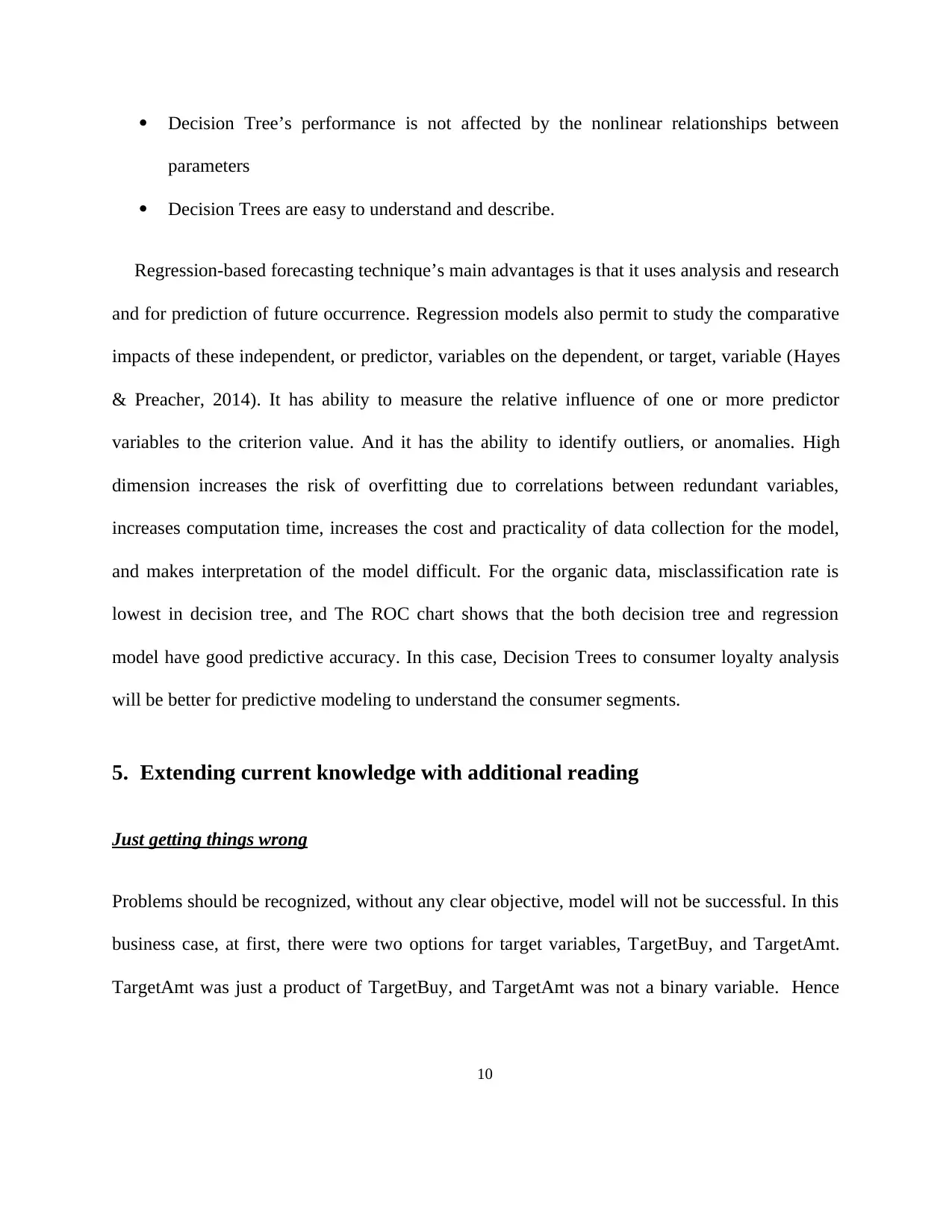
Decision Tree’s performance is not affected by the nonlinear relationships between
parameters
Decision Trees are easy to understand and describe.
Regression-based forecasting technique’s main advantages is that it uses analysis and research
and for prediction of future occurrence. Regression models also permit to study the comparative
impacts of these independent, or predictor, variables on the dependent, or target, variable (Hayes
& Preacher, 2014). It has ability to measure the relative influence of one or more predictor
variables to the criterion value. And it has the ability to identify outliers, or anomalies. High
dimension increases the risk of overfitting due to correlations between redundant variables,
increases computation time, increases the cost and practicality of data collection for the model,
and makes interpretation of the model difficult. For the organic data, misclassification rate is
lowest in decision tree, and The ROC chart shows that the both decision tree and regression
model have good predictive accuracy. In this case, Decision Trees to consumer loyalty analysis
will be better for predictive modeling to understand the consumer segments.
5. Extending current knowledge with additional reading
Just getting things wrong
Problems should be recognized, without any clear objective, model will not be successful. In this
business case, at first, there were two options for target variables, TargetBuy, and TargetAmt.
TargetAmt was just a product of TargetBuy, and TargetAmt was not a binary variable. Hence
10
parameters
Decision Trees are easy to understand and describe.
Regression-based forecasting technique’s main advantages is that it uses analysis and research
and for prediction of future occurrence. Regression models also permit to study the comparative
impacts of these independent, or predictor, variables on the dependent, or target, variable (Hayes
& Preacher, 2014). It has ability to measure the relative influence of one or more predictor
variables to the criterion value. And it has the ability to identify outliers, or anomalies. High
dimension increases the risk of overfitting due to correlations between redundant variables,
increases computation time, increases the cost and practicality of data collection for the model,
and makes interpretation of the model difficult. For the organic data, misclassification rate is
lowest in decision tree, and The ROC chart shows that the both decision tree and regression
model have good predictive accuracy. In this case, Decision Trees to consumer loyalty analysis
will be better for predictive modeling to understand the consumer segments.
5. Extending current knowledge with additional reading
Just getting things wrong
Problems should be recognized, without any clear objective, model will not be successful. In this
business case, at first, there were two options for target variables, TargetBuy, and TargetAmt.
TargetAmt was just a product of TargetBuy, and TargetAmt was not a binary variable. Hence
10
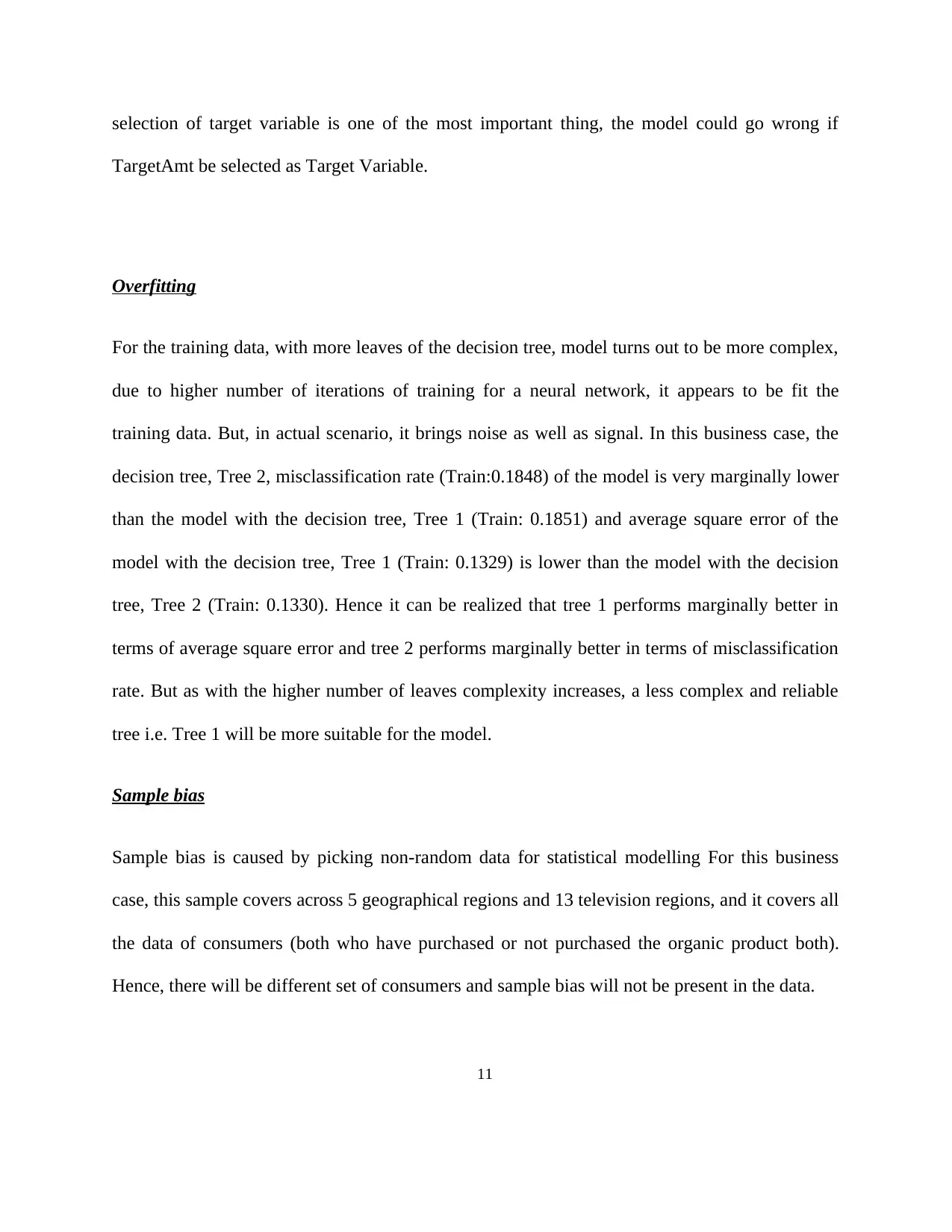
selection of target variable is one of the most important thing, the model could go wrong if
TargetAmt be selected as Target Variable.
Overfitting
For the training data, with more leaves of the decision tree, model turns out to be more complex,
due to higher number of iterations of training for a neural network, it appears to be fit the
training data. But, in actual scenario, it brings noise as well as signal. In this business case, the
decision tree, Tree 2, misclassification rate (Train:0.1848) of the model is very marginally lower
than the model with the decision tree, Tree 1 (Train: 0.1851) and average square error of the
model with the decision tree, Tree 1 (Train: 0.1329) is lower than the model with the decision
tree, Tree 2 (Train: 0.1330). Hence it can be realized that tree 1 performs marginally better in
terms of average square error and tree 2 performs marginally better in terms of misclassification
rate. But as with the higher number of leaves complexity increases, a less complex and reliable
tree i.e. Tree 1 will be more suitable for the model.
Sample bias
Sample bias is caused by picking non-random data for statistical modelling For this business
case, this sample covers across 5 geographical regions and 13 television regions, and it covers all
the data of consumers (both who have purchased or not purchased the organic product both).
Hence, there will be different set of consumers and sample bias will not be present in the data.
11
TargetAmt be selected as Target Variable.
Overfitting
For the training data, with more leaves of the decision tree, model turns out to be more complex,
due to higher number of iterations of training for a neural network, it appears to be fit the
training data. But, in actual scenario, it brings noise as well as signal. In this business case, the
decision tree, Tree 2, misclassification rate (Train:0.1848) of the model is very marginally lower
than the model with the decision tree, Tree 1 (Train: 0.1851) and average square error of the
model with the decision tree, Tree 1 (Train: 0.1329) is lower than the model with the decision
tree, Tree 2 (Train: 0.1330). Hence it can be realized that tree 1 performs marginally better in
terms of average square error and tree 2 performs marginally better in terms of misclassification
rate. But as with the higher number of leaves complexity increases, a less complex and reliable
tree i.e. Tree 1 will be more suitable for the model.
Sample bias
Sample bias is caused by picking non-random data for statistical modelling For this business
case, this sample covers across 5 geographical regions and 13 television regions, and it covers all
the data of consumers (both who have purchased or not purchased the organic product both).
Hence, there will be different set of consumers and sample bias will not be present in the data.
11
⊘ This is a preview!⊘
Do you want full access?
Subscribe today to unlock all pages.

Trusted by 1+ million students worldwide
1 out of 25
Related Documents
Your All-in-One AI-Powered Toolkit for Academic Success.
+13062052269
info@desklib.com
Available 24*7 on WhatsApp / Email
![[object Object]](/_next/static/media/star-bottom.7253800d.svg)
Unlock your academic potential
Copyright © 2020–2025 A2Z Services. All Rights Reserved. Developed and managed by ZUCOL.





